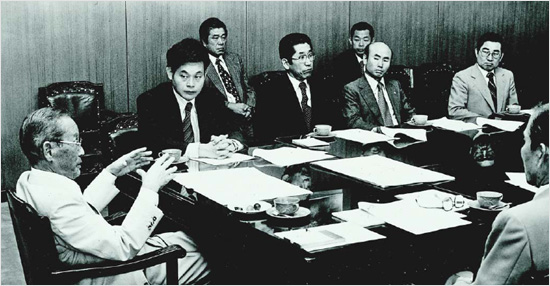
Leadership and Affiliates
Leadership
Lee Byung-chul (1938–1966, 1968–1987)
Lee Maeng-hee (1966–1968), Lee Byung-chul's first son
Lee Kun-hee (1987–2008, 2010–2020), Lee Byung-chul's third son
Lee Soo-bin (2008–2010)
Samsung Electronics is a multinational electronics and information technology company headquartered in Suwon and the flagship company of the Samsung Group.[59] Its products include air conditioners, computers, digital televisions, active-matrix organic light-emitting diodes (AMOLEDs), mobile phones, monitors, printers, refrigerators, semiconductors and telecommunications networking equipment.
Samsung Biologics is a biopharmaceutical division of Samsung, founded in 2011. It has contract development and manufacturing (CDMO) services including drug substance and product manufacturing and bioanalytical testing services. The company is headquartered in Incheon, South Korea and its existing three plants comprises the largest biologic contract manufacturing complex. It expanded its contract development service lab to San Francisco, U.S. Samsung Biologics is listed on the Korean Exchange stock market (number 207940).[64] Samsung Bioepis is a biosimilar medicine producer and joint venture between Samsung Biologics (50 percent plus one share) and the U.S.-based Biogen Idec (50 percent).[65] [66] In 2014, Biogen Idec agreed to commercialize future anti-TNF biosimilar products in Europe through Samsung Bioepis.[67]
Samsung Engineering is a multinational construction company headquartered in Seoul. It was founded in January 1969. Its principal activity is the construction of oil refining plants; upstream oil and gas facilities; petrochemical plants and gas plants; steel making plants; power plants; water treatment facilities; and other infrastructure.[68] It achieved total revenues of 9,298.2 billion won (US$8.06 billion) in 2011.[69] Samsung Engineering is listed on the Korea Exchange stock market (number 02803450).
Samsung Fire & Marine Insurance is a multinational general insurance company headquartered in Seoul.[70] It was founded in January 1952 as Korea Anbo Fire and Marine Insurance and was renamed Samsung Fire & Marine Insurance in December 1993.[71] Samsung Fire & Marine Insurance offers services including accident insurance, automobile insurance, casualty insurance, fire insurance, liability insurance, marine insurance, personal pensions and loans.[72] As of March 2011 it had operations in 10 countries and 6.5 million customers. Samsung Fire & Marine Insurance had a total premium income of $11.7 billion in 2011 and total assets of $28.81 billion on 31 March 2011. It is the largest provider of general insurance in South Korea. Samsung Fire has been listed on the Korea Exchange stock market since 1975 (number 000810).
[72]
Samsung Heavy Industries is a shipbuilding and engineering company headquartered in Seoul. It was founded in August 1974. Its principal products are bulk carriers, container vessels, crude oil tankers, cruisers, passenger ferries, material handling equipment steel and bridge structures.[73] It achieved total revenues of 13,358.6 billion won in 2011 and is the world's second-largest shipbuilder by revenues (after Hyundai Heavy Industries).[74]
[75] Samsung Heavy Industries is listed on the Korea Exchange stock market (number 010140).